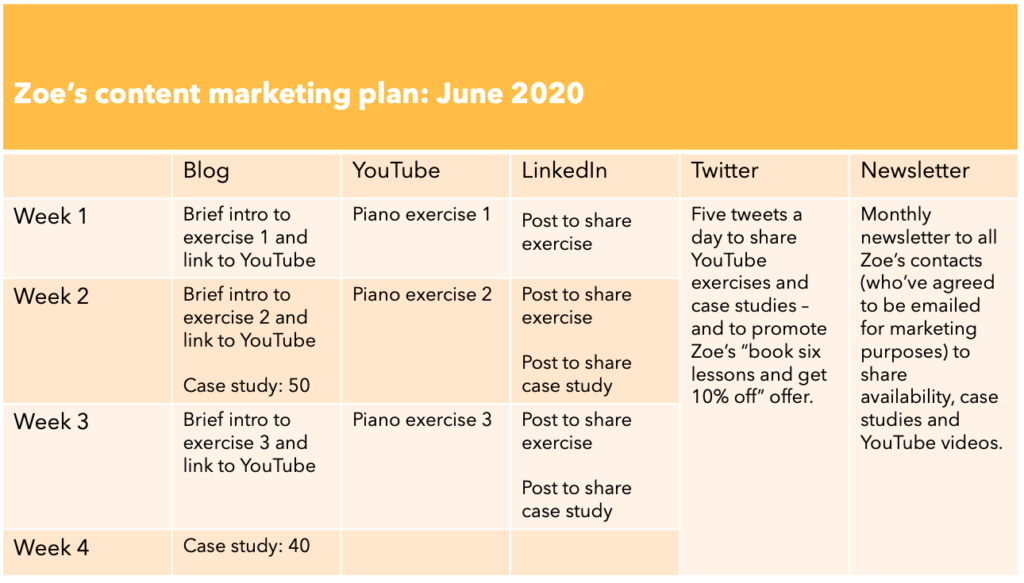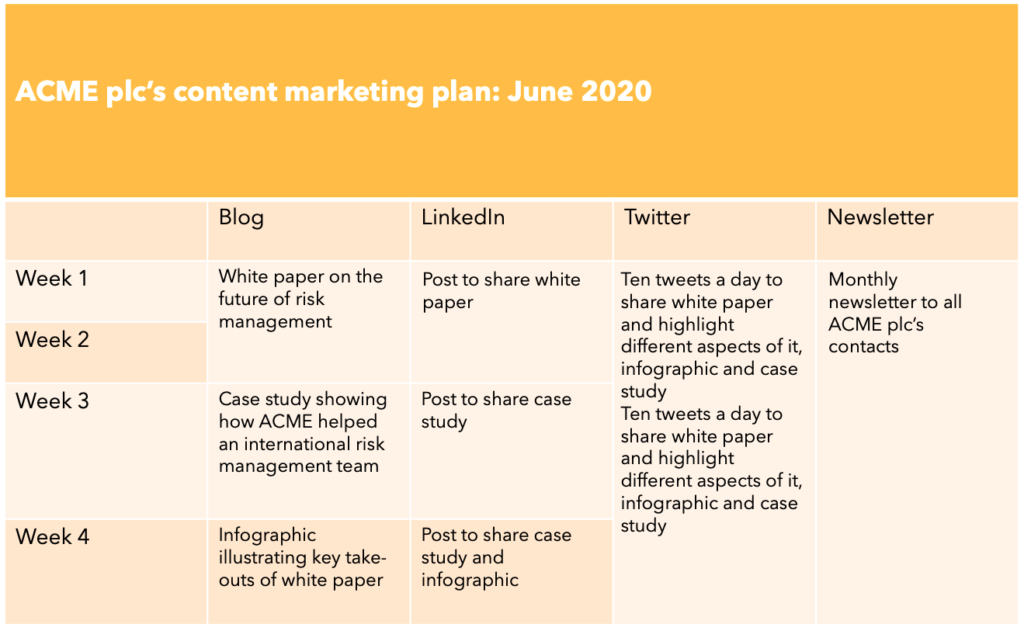
When your organisation first starts thinking about creating a content marketing strategy, it can be difficult to know where to begin.
In fact, many organisations spend a lot of time and energy creating content and sharing it – and then seeing little return on the investment. So how do you start?
At very top level, this is what we’d suggest:
1. Ask yourself two fundamental questions: Who do you want to engage with, and what do you want them to do?
Let’s imagine a self-employed piano teacher. Her most important audience is going to be people who’d like to learn to play the piano. In fact, she decides that she only wants to teach adult beginners and adult improvers – and that she can teach them in person or online.
So she starts her content marketing by identifying her audiences:
Adult beginners and improvers.
Now she goes to the second question and decides that she’d like her audiences to do three things:
- Sign up for blocks of lessons
- Pay to download beginner sheet music
- Recommend her to other learner pianists
2. Understand as much as you can about your target audiences
So our piano teacher – let’s call her Zoe – knows that she wants to reach adult piano learners, and that they can be anywhere in the world, because she can teach online.
If she’s going to create content that will appeal to her audiences, she needs to understand what interests them so much that they’ll search for it online. Because content marketing is all about making sure that when your audience searches for something to do with the product or service you offer, they find your content… which helps them to form a relationship with you and buy from you.
So Zoe talks to her existing adult learners. And she hangs out on a couple of online music forums. And she puts herself in the shoes of her audiences. “What,” she asks herself, “Is it like to be them? What are they concerned about? What makes them happy?”.
It turns out that adult piano learners:
- Struggle to find time to practise
- Are often working in demanding professional jobs
- Are concerned about sitting down all the time
- But love to lose themselves in piano practice
- They love being creative
- And feel a great sense of accomplishment from learning new things
These are all great subject areas that Zoe can begin to use as themes for the content she creates and shares.
It also gives Zoe a sense of where her ideal audiences may be hanging out online. A lot of them, she realises, are likely to spend at least a couple of hours each week on LinkedIn and on twitter. They also like to learn from YouTube.
3. Draw up a simple, achievable plan
By now, you should know who you ideally want to find your content with the searches they make. You know at least something about what interests them/concerns them – and you know where they’re hanging out online.
These three elements give you the starting points for your strategy.
Now comes the fun bit. You need to think carefully about what kinds of things these people are looking up online.
For Zoe, some of the terms might be really obvious:
- Adult piano lessons
- Adult piano lessons in Bicester
- Piano lessons for grown-ups
Some might be less obvious:
- Am I too old to learn the piano?
- Learning piano at 50
- Learning piano at 40
- Quick piano exercises you can do every day
This begins to give Zoe ideas for the kinds of content she can create. She decides to video herself doing three simple exercises – including one about finger dexterity that you could do at work if you wanted to.
She also decides to write two case studies about students who have learned to play the piano aged 50 and 40.
Then she sets this out in a schedule:

There’s a misconception that content marketing is free – and that it brings massive ROI. It isn’t – and it won’t. At least not initially.
Zoe estimates that it will take her half a day to make the three videos – and it will take her another day to create the case studies. It will then take her a couple of hours to set up a template for her newsletter on Mailchimp – and perhaps another hour each month to write the contents of it.
It’s also going to take her an hour to write and schedule tweets in TweetDeck (a free tool from Twitter that lets you queue up your tweets for the whole week, and then automatically shares them).
She estimates that the time she’ll spend – plus the monthly cost of Mailchimp – is equivalent to her charging for six lessons. And she thinks that if one person buys a block of six lessons, then her efforts will have paid for themselves.
In July, she decides that she will add one more case study, and will continue to re-use her old content, refreshing the wording of her tweets and LinkedIn posts.
In other words, she knows there’ll be an initial splurge of effort to get her content marketing ball rolling. But after that, it will become manageable and routine for her.
Importantly, her approach is strategic. She isn’t sharing any old content for the sake of sharing content. She’s very carefully targeting the kinds of people she wants to teach, with the types of content she thinks they’ll be interested in, in the online places she believes they’ll be hanging out.
If she’s sensible, she’ll give herself a few months trying this approach, she’ll monitor the results she gets – and if she feels like doing more, she can up the ante once her initial approach has become an easy part of her routine.
What about B2B organisations?
The same, top-level approach works for content marketing for B2B organisations. You start by asking yourself: Who do we want as customers? What do we want them to do when they read our content?
For ACME plc, its ideal audiences might be senior decision makers in risk management. And as a result of reading ACME’s content, they may want the decision maker to get in touch and organise a meeting.
So they then go to step two and find out everything they can about senior risk managers. They find that they:
- Have long purchasing cycles
- Prioritise international compliance
- Are beginning to work with HR on resilience programmes
- Are concerned about trade wars, embargoes and the need for constantly up-to-date policy (and adoption)
- Are concerned about the growing complexity of their role
- Are likely to read one of three international risk management publications
- Use LinkedIn and twitter for business-related content
These insights give ACME plc plenty of ideas for the kinds of content their ideal customers might be looking for – and where they might go to find it. So they draw up a manageable plan:

In July, ACME plc collaborates with International Risk Management Super Magazine to publish a thought piece on the evolving role of the risk manager. They then link to IRMSM.com from their blog, and tweet and post about the article on LinkedIn.
The only difference between Zoe the piano teacher’s content marketing approach and ACME plc’s is likely to be the amount of time it takes for the marketing to convert. ACME’s customers have long buying cycles – so they know they’re relationship-building in the long term. Zoe’s don’t, and it’s reasonable for her to expect to start getting results in weeks, rather than the months and years it may take ACME plc.
You can read our thoughts about B2B content marketing here.
But isn’t there more to it than this?
Yes, of course. When you’re creating content that you hope will correspond to what your ideal customers are searching for, then you need to be clued into search terms, and you need to be able to create really nice content. You also need to monitor what you’re doing and tweak to make improvements as you go along. These are all subjects we’ll be covering in coming weeks.
You can sign up to our newsletter to find out when we publish the next instalment of this beginner’s guide to content marketing. Or you can get in touch to talk about your plans (especially if you’re a B2B organisation that thinks it might need a hand creating a strategy and content).
You might also find our content marketing FAQs interesting.
You can also check out: What is content marketing? (And how do you make it work for your organisation?)
